Book Review: How to Decide by Annie Duke

The most valuable way that the best boards contribute to an organisation is by making high quality decisions.
But where do we learn to make high quality decisions?
Many of us are familiar with pros and cons lists when weighing up various solutions to the issue before us, but it turns out that this approach is flawed. And when it comes to the success (or not) of our decisions, the outcome is not indicative of how good (or not) our decision-making process was.
Yeah, that took me a while to get my head around.
When we’re faced with significant decisions to make in the boardroom or in our personal lives, it’s time to throw away the pros and cons list and upgrade the way we think about, work through, and ultimately decide on a solution.
In her book ‘How to Decide: Simple Tools for Making Better Choices’ Annie Duke shows us the way. Here’s my review of this book.
Connection to author / how I came about reading this book.
I first came across Annie Duke on the Art of Manliness Podcast (a podcast not just for blokes, BTW). I enjoyed that podcast enough to borrow the audio book from Libby (a way to borrow audio books for free from your local library). I got two chapters in and immediately ordered the physical book.
I was drawn to this book because I can appreciate the value in a robust decision-making process, particularly for teams (like a Board), for leaders, and for life. Not for every little decision (even though we can all probably get better at those), but for big decisions with a lot on the line.
I wanted to learn about how we can better make decisions, the techniques to do so, and the things holding us back from making sound decisions, including how we can get in our own way.
This book in a nutshell.
Annie breaks her book into three main sections.
The first three chapters help us to understand the hazards of learning from experience (i.e. the outcomes from previous decisions) and how we can better understand what the past has to teach us, including the contribution that luck (both good and bad) can play in the outcomes we experience, and how this can inform our future decisions.
Next, Annie sets out a framework for making high-quality decisions, including tools to deal with uncertainty, our existing beliefs and knowledge, and how to determine when more time is needed for a quality decision to be made.
The closing chapters help you to identify obstacles that might lie in your path, and how you can better use the knowledge and information that other people have to get to a better decision. It also guides you through how to elicit feedback from others and avoiding group-think and other cognitive biases we all can fall victim to.
This book has a ton of prompts and exercises for you to work through to learn the tools and techniques Annie is sharing. I recommend digitising these so that you can use them for your decision-making moments.
Why read it?
We are products of the all the decisions we make, including the seemingly insignificant ones, so it will benefit you to understand ways in which we can make better decisions (sometimes regardless of the outcome).
The need for this skill is amplified for board members. We can play a role in leading our board colleagues towards a better process for making the decisions that we’re charged to make as boards. Our employees, customers, and stakeholders rely on us and expect us to have these skills and deploy them when necessary.
I thought that I was balanced and considered when making decisions, but Annie helped me to understand that I wasn’t using many of the methods, techniques, and tools available to improve how I make decisions and contribute to decisions in the boardroom. It was also clear that I was conflating decision outcomes with decision-making quality. It turns out that one does not equal the other. For that revelation alone, I think it’s worth reading (or listening to) this book.
Best piece of advice?
If every potential decision is right, then there is no wrong answer.
Sometimes, when you’ve worked through all of the methods to determine potential outcomes, their likelihood (best estimate given imperfect information), your preference for each outcome, using the outside view, premortems, back-casting, and everything in between, you still can’t decide what to do.
To break through analysis paralysis or feeling like you might make the ‘wrong’ decision it may be time to select any decision from the available options. The time spent deciding versus the added contribution to decision quality tips in the wrong direction. If all decisions can be ‘right’ then there’s no wrong decision. Choose one and move on.
I feel like this may benefit moments when a board is evenly split on a decision where opposing views are equal. In these moments it may be that one decision is agreed to because it’s better to have a decision rather than to invest more time trying to come up with a ‘better’ decision. At the appropriate moment, it’s up to us holding a certain view to release the grip a little bit to enable a decision to be made.
The personal impact
As I was reading this book, I had two major decisions to make in my personal and professional life. This process has helped me to reach a point where I can stop analysing and ruminating and act. I didn’t realise how much head space it was taking up and how freeing it has been to decide.
Working through the processes in the book has also helped me to learn about myself and how I handle uncertainty, risk, and what I need to have to feel comfortable when making a decision (for example, I need a fallback or to see that if everything goes pear-shaped, I have a plan).
Get Your Copy of How to Decide
How to Decide by Annie Duke (Amazon.com.au)
